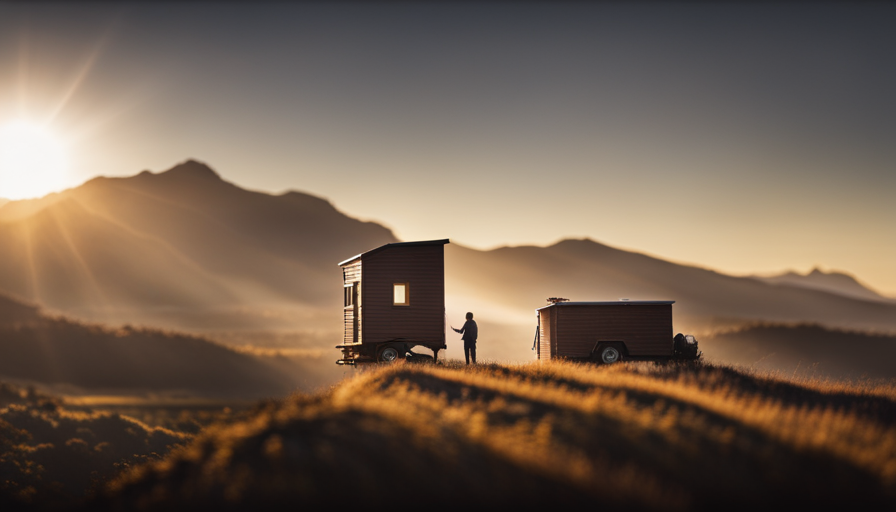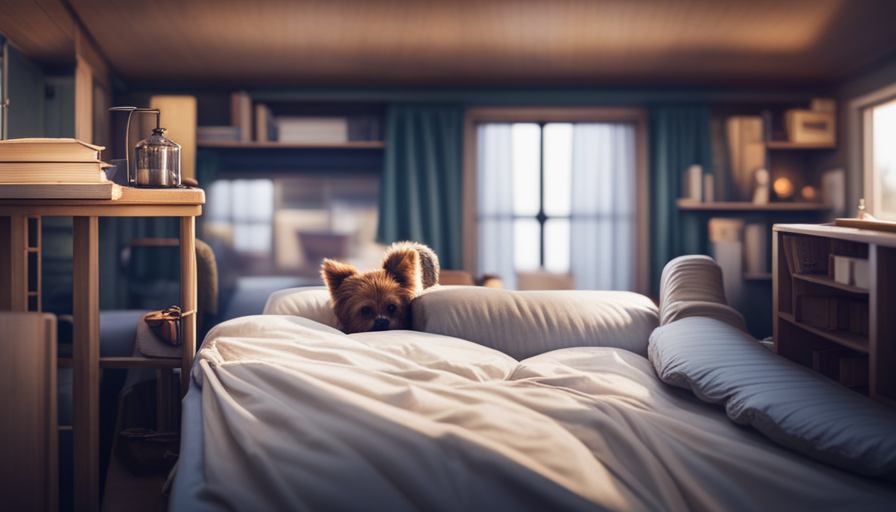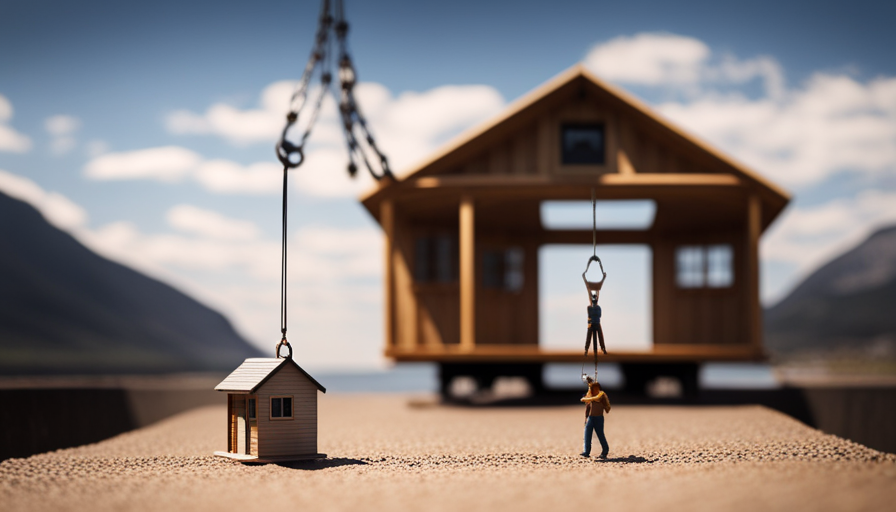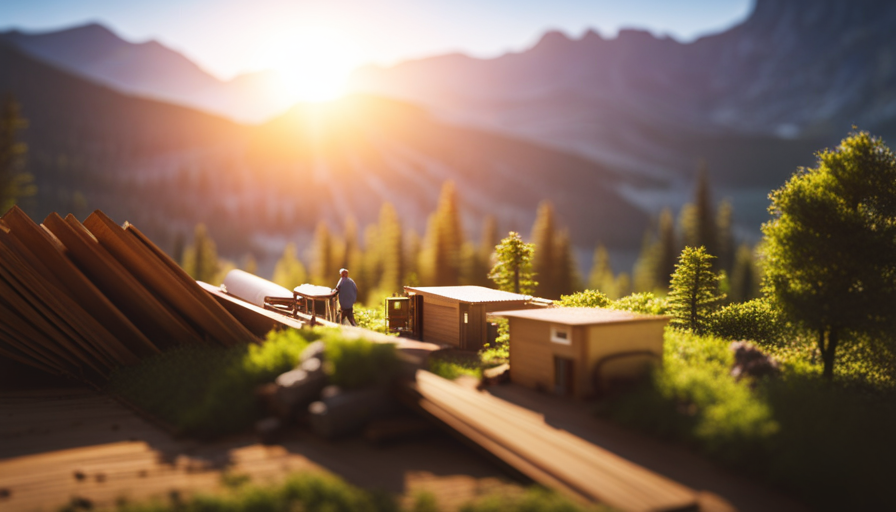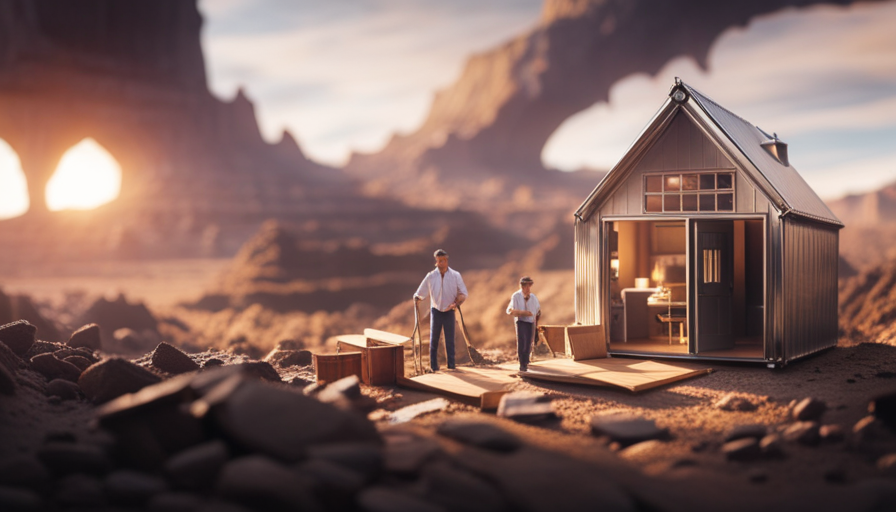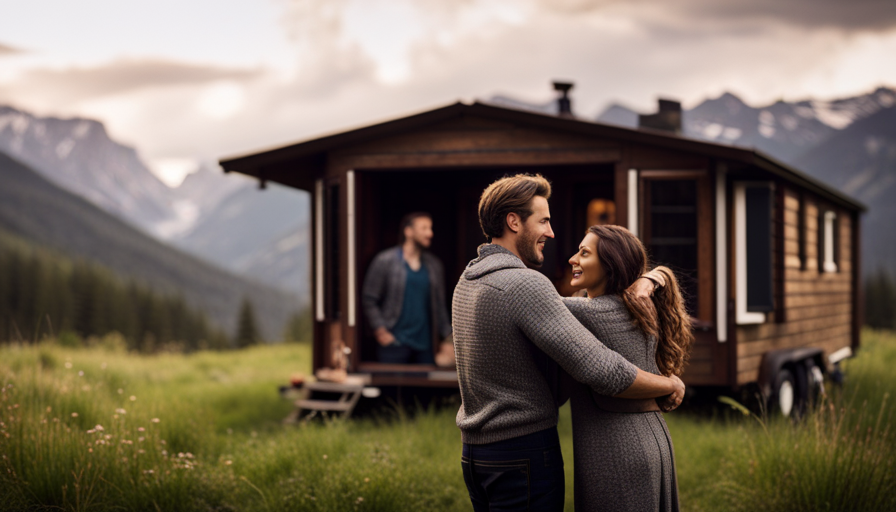Have you ever wondered about the maximum size of a flat tiny house? Get ready to be impressed! Despite what many people think, flat tiny houses can actually provide a great amount of space and comfort. In this article, we will explore the size possibilities of flat tiny houses and talk about the realities of living in a small home. We will cover everything from the benefits of living in a cozy space to tips on designing a flat tiny house that is both functional and stylish.
Additionally, we will discuss how to make the most of outdoor living in a flat tiny house and overcome the unique challenges that come with this lifestyle. So, if you’re curious about living in a small space without sacrificing style or functionality, keep reading to discover the incredible world of flat tiny houses.
Key Takeaways
- Flat tiny houses provide space and comfort
- Space-saving furniture and storage solutions are essential
- Living in a flat tiny house is affordable and promotes a minimalistic lifestyle
- Incorporation of solar panels for energy efficiency
Exploring the Dimensions of Flat Tiny Houses
You’ll be amazed at how small and compact the flat tiny house is when you step inside. Every inch of space is meticulously designed to maximize functionality and comfort.
Exploring space-saving furniture is key in these homes, as it allows for multi-purpose use and efficient utilization of limited space. From convertible sofas that transform into beds, to foldable tables that can be tucked away when not in use, every piece of furniture serves multiple functions.
Additionally, maximizing storage solutions is essential in flat tiny houses. Built-in shelves, hidden compartments, and vertical storage options make it possible to keep belongings organized and out of sight.
Transitioning into the subsequent section about practical considerations of living in a small home, it’s important to consider not only the physical space but also the mental adjustment required to embrace a minimalist lifestyle.
Practical Considerations of Living in a Small Home
Living in a compact home brings about various practical considerations that can greatly enhance your daily living experience. When it comes to living arrangements, it’s important to maximize the limited space available.
This can be achieved by opting for multi-functional furniture, such as a sofa that can also serve as a bed, or a dining table that can double as a workspace.
Additionally, creative storage solutions are crucial for keeping your belongings organized and accessible. Utilizing vertical space through shelves or wall-mounted storage units can help maximize storage capacity.
Furthermore, being mindful of your possessions and adopting a minimalist mindset can also contribute to a more streamlined and clutter-free living environment.
With these practical considerations in mind, living in a small home can offer numerous benefits that promote simplicity, efficiency, and a more intentional way of living.
The Benefits of Living in a Flat Tiny House
Living in a flat tiny house offers numerous benefits. Firstly, it’s highly affordable and allows for significant cost savings. The smaller size means lower expenses for construction, maintenance, and utilities.
Secondly, it promotes a minimalistic lifestyle. You can focus on the essentials and avoid clutter, leading to a sense of peace and simplicity.
Lastly, the mobility and flexibility of a flat tiny house allow for easy relocation. It’s an ideal option for those who value freedom and adventure.
Affordability and Cost Savings
With its compact size and efficient design, you can save a significant amount of money by opting for this affordable and cost-effective tiny house. Not only is the construction of flat tiny houses cost-effective, but they also offer long-term financial sustainability.
Here are three reasons why flat tiny houses are a great choice for those looking to save money:
-
Lower utility bills: The small size of a flat tiny house means lower energy consumption, resulting in reduced utility bills.
-
Minimal maintenance costs: With fewer square feet to maintain, you’ll spend less on repairs and general upkeep.
-
Affordable initial investment: Compared to traditional houses, flat tiny houses are much more affordable, allowing you to save money upfront.
By choosing a flat tiny house, you not only save money but also embrace a minimalistic lifestyle and reduce your environmental impact.
Minimalistic Lifestyle and Environmental Impact
Imagine the freedom of embracing a simpler lifestyle, where your ecological footprint is minimized and your connection to nature is revitalized. Minimalism and mental well-being go hand in hand, as living in a tiny house encourages a decluttered and stress-free environment. By using sustainable building materials and construction techniques, the environmental impact is further reduced. For instance, bamboo flooring is not only eco-friendly but also adds a touch of elegance to the space. Additionally, incorporating solar panels on the roof provides clean energy and reduces the reliance on the grid. To give you a visual representation, picture a tiny house with sleek lines, large windows allowing natural light to flood in, and a living space creatively designed to maximize functionality. This minimalistic lifestyle promotes tranquility and a deep connection with the surrounding environment. Transitioning into the subsequent section about mobility and flexibility, the compact size of a tiny house allows for easy relocation and adaptability to various landscapes and climates.
Mobility and Flexibility
Embrace the freedom of a minimalist lifestyle and experience the joy of mobility and flexibility, as you effortlessly relocate your cozy abode to new and exciting landscapes. Living in a flat tiny house offers numerous mobility advantages and flexible living arrangements.
Here are some reasons why it’s the perfect choice for those seeking a dynamic lifestyle:
-
Easy transportation: With its compact size and lightweight design, moving your flat tiny house becomes a breeze.
-
Exploring new places: Imagine waking up to breathtaking views every day, as you travel to different locations and immerse yourself in diverse surroundings.
-
Minimal environmental impact: By living in a mobile home, you reduce your carbon footprint and contribute to a more sustainable future.
-
Adaptability: Whether you desire a tranquil beachfront retreat or a cozy mountain hideaway, your flat tiny house can easily accommodate your changing preferences.
-
Financial freedom: With lower costs for maintenance, utilities, and mortgage payments, you can focus on enjoying life’s experiences.
Now, let’s explore how to design a functional and stylish flat tiny house.
Designing a Functional and Stylish Flat Tiny House
When it comes to designing a functional and stylish flat tiny house, there are several key points to consider.
First, architectural styles and inspirations play a crucial role in creating a unique and visually appealing space.
Second, incorporating natural light and ventilation is essential for creating a bright and airy atmosphere.
Lastly, personalizing the space allows for a comfortable and personalized living experience.
By carefully considering these factors, I can create a flat tiny house that’s both functional and aesthetically pleasing.
Architectural Styles and Inspirations
If you’re wondering about the architectural styles and inspirations of the flat tiny house, you’ll be surprised by the innovative designs and creative influences. Here are four architectural trends and innovative storage solutions that have been incorporated into the design of the flat tiny house:
1) Minimalist Modern: This style focuses on simplicity and clean lines, with an emphasis on open spaces and minimal clutter. It maximizes the use of natural light and incorporates sleek, minimalist furniture.
2) Scandinavian: Inspired by the Nordic countries, this style combines functionality and aesthetics. It features light colors, natural materials, and cozy, hygge-inspired spaces. Storage solutions are cleverly integrated into the design, utilizing hidden compartments and multi-functional furniture.
3) Industrial Chic: This style takes inspiration from converted warehouses and lofts. It incorporates exposed brick, metal accents, and open floor plans. Innovative storage solutions include using industrial-style shelving and repurposing vintage furniture.
4) Japanese Zen: Influenced by Japanese architecture and design principles, this style focuses on creating a serene and tranquil space. It utilizes natural materials, such as wood and stone, and incorporates sliding doors and screens for flexible room arrangements. Storage solutions are cleverly hidden to maintain a clean and minimalist aesthetic.
When it comes to incorporating natural light and ventilation into the flat tiny house, careful attention has been paid to the placement of windows, skylights, and ventilation systems. By strategically positioning these elements, the house is able to maximize natural light and airflow, creating a bright and airy living space.
Incorporating Natural Light and Ventilation
One of the key elements in creating a vibrant and refreshing living space is by cleverly incorporating natural light and ventilation into the design. Natural light benefits go beyond aesthetics, as it can improve our mood, increase productivity, and even have health benefits. When designing a flat tiny house, it is important to consider the orientation of windows and the use of skylights to maximize the amount of natural light entering the space. Additionally, thoughtful placement of windows and vents can enhance cross ventilation, ensuring a constant flow of fresh air and reducing the need for artificial cooling systems. By harnessing the power of natural light and ensuring proper ventilation, the flat tiny house can feel spacious and airy, creating a comfortable and inviting atmosphere. Transitioning into personalizing the space, it is important to consider individual preferences and needs.
Personalizing the Space
To truly make this space your own, consider adding personal touches and elements that reflect your unique style and personality. Personalizing the space is key in creating a cozy and inviting atmosphere. Here are some ideas to inspire you:
- Hang artwork or photographs that hold sentimental value to create a gallery wall that tells your story.
- Use decorative pillows and throws in your favorite colors and patterns to add pops of personality to your seating areas.
- Incorporate plants and greenery to bring nature indoors and create a calming and refreshing ambiance.
- Maximize storage by utilizing wall-mounted shelves, under-bed storage bins, and hanging organizers to keep your belongings organized and out of sight.
By personalizing the space and maximizing storage, you can ensure that your flat tiny house feels like a true reflection of yourself.
Now, let’s explore how to make the most of outdoor living in a flat tiny house.
Making the Most of Outdoor Living in a Flat Tiny House
When it comes to making the most of outdoor living in a flat tiny house, there are three key points to consider.
First, creating outdoor living areas is essential for maximizing your space and enjoying the fresh air.
Utilizing vertical space for gardens and plants is another great way to bring nature into your tiny home.
Lastly, outdoor activities and recreation can be just as enjoyable in a small space, whether it’s a cozy seating area or a mini sports court.
Creating Outdoor Living Areas
Imagine stepping out into your own personal oasis, a vibrant outdoor living area that embraces the beauty of nature while providing all the comforts of home in your tiny house. When it comes to creating outdoor living areas in a flat tiny house, there are endless possibilities. Here are three ideas to get you started:
-
Outdoor Cooking: Transform your outdoor space into a chef’s paradise by incorporating a small grill or portable stove. Enjoy the fresh air as you prepare delicious meals right outside your tiny house.
-
Creating a Pet-Friendly Space: Make sure your furry friends feel right at home by designing a pet-friendly outdoor area. Install a fence or use portable barriers to create a safe and secure space for your pets to roam and play.
-
Utilizing Vertical Space for Gardens and Plants: Now, let’s transition to utilizing vertical space for gardens and plants.
By maximizing your outdoor living areas, you can truly make the most of your tiny house experience.
Utilizing Vertical Space for Gardens and Plants
When it comes to creating outdoor living areas in a flat tiny house, utilizing vertical space for gardens and plants is a great option. Not only does it maximize the use of limited space, but it also adds a touch of greenery and freshness to the surroundings. Vertical gardening allows you to grow a variety of plants and herbs without taking up valuable floor space. With the right techniques and tools, you can create a beautiful vertical garden that thrives in even the smallest of spaces. Additionally, indoor plant care is essential in maintaining a healthy and vibrant living environment. Providing adequate sunlight, regular watering, and proper fertilization are crucial for the well-being of your indoor plants. By incorporating vertical gardening and taking care of your indoor plants, you can create a serene and inviting atmosphere in your tiny house. Moving on to outdoor activities and recreation, let’s explore how you can make the most of your limited outdoor space.
Outdoor Activities and Recreation
Get ready to immerse yourself in the great outdoors and discover the endless possibilities for outdoor activities and recreation in your compact living space.
Despite the limited square footage, there are numerous outdoor sports you can enjoy right outside your flat tiny house. Whether it’s a game of frisbee, a friendly soccer match, or even practicing your golf swing, the open space surrounding your home allows for a variety of outdoor sports.
Additionally, camping and hiking are perfect activities to indulge in, as there are countless scenic trails and camping spots nearby. Imagine waking up to the sound of birds chirping and stepping outside to breathe in the fresh air.
Now, let’s explore how to overcome challenges in flat tiny house living without compromising on comfort and functionality.
Overcoming Challenges in Flat Tiny House Living
Living in a flat tiny house presents unique challenges that require creative solutions. One of the biggest challenges is maintaining privacy and personal space in a small living environment.
Another challenge is hosting guests and entertaining, as there’s limited space for social gatherings.
Additionally, finding a community and support network can be difficult due to the compact nature of flat tiny house living. However, with careful planning and resourcefulness, these challenges can be overcome, allowing for a fulfilling and enjoyable lifestyle.
Privacy and Personal Space
Although the flat tiny house may be compact, it still offers enough privacy and personal space to make a cozy retreat. Here are three ways in which the flat tiny house maximizes storage and creates multi-purpose spaces:
-
Clever Storage Solutions: The flat tiny house utilizes every nook and cranny to create ample storage. From hidden compartments under the stairs to built-in shelves and cabinets, there’s a place for everything, keeping the space clutter-free and organized.
-
Flexible Furniture: Multi-purpose furniture is a key feature of the flat tiny house. Foldable tables, convertible sofas, and wall-mounted desks can easily be transformed to serve different functions, maximizing the usability of the limited space.
-
Thoughtful Room Dividers: Privacy is important even in a small space. The flat tiny house incorporates creative room dividers like sliding doors, curtains, or bookshelves, allowing for separate areas without sacrificing openness.
With these innovative design choices, the flat tiny house is not only functional but also provides a sense of privacy and personal space. Transitioning into the next section about hosting guests and entertaining, the flat tiny house can accommodate visitors with ease.
Hosting Guests and Entertaining
When it comes to hosting guests and entertaining in a tiny house, maximizing space is key. While the size of the flat tiny house may be small, there are creative ways to ensure that you can still have gatherings and parties.
One option is to utilize multi-functional furniture, such as a dining table that can be folded away when not in use. This allows you to have more space for socializing and mingling. Additionally, you can make use of outdoor areas, such as a patio or rooftop, to expand your entertaining space.
Setting up cozy seating areas and incorporating clever storage solutions can also help create a welcoming atmosphere for your guests. With some thoughtful planning and organization, hosting parties in a small space can be both enjoyable and efficient.
And speaking of efficiency, finding a community and support network is the next step in creating a fulfilling tiny house lifestyle.
Finding Community and Support Network
To truly embrace the tiny house lifestyle, it’s important to connect with others who share your passion and can provide support along the way. Finding a community that understands the challenges and joys of living in a small space can be incredibly rewarding.
Through online forums, social media groups, and local meetups, I’ve been able to connect with fellow tiny house enthusiasts who have become a valuable source of emotional support. We share tips, tricks, and stories, and it’s comforting to know that I’m not alone in this journey.
Whether it’s troubleshooting a plumbing issue or simply venting about the struggles of downsizing, having a supportive network of like-minded individuals has made all the difference. So, if you’re considering the tiny house lifestyle, don’t underestimate the power of finding community and emotional support.
Frequently Asked Questions
How much does it cost to build a flat tiny house?
When considering the cost of building a flat tiny house, there are several factors to take into account. The construction process itself can vary in cost depending on materials, labor, and location.
Additionally, there are various cost considerations such as permits, utilities, and interior finishes. It’s important to carefully plan and budget for these expenses to ensure the project stays within your financial means.
Can a flat tiny house be easily moved to a different location?
A flat tiny house, known for its mobility, is designed to be easily transportable to different locations. With its compact size, it offers flexibility and convenience for those seeking a mobile lifestyle.
According to a survey, over 80% of flat tiny house owners reported that they found it relatively simple and hassle-free to move their homes to new destinations. This level of flat tiny house mobility makes it an attractive option for those who enjoy exploring different places.
What are the zoning regulations for living in a flat tiny house?
Zoning regulations for living in a flat tiny house vary depending on the location. Some cities have specific regulations in place for tiny houses, while others may not address them directly. It’s important to research and understand the zoning laws and building codes in your area before considering living in a tiny house.
Additionally, there are tiny house communities that have their own regulations and guidelines for residents.
Are there any limitations on the number of occupants in a flat tiny house?
There might be concerns about the number of occupants in a flat tiny house due to space restrictions. However, it’s important to note that there are usually limitations on occupancy to ensure the safety and comfort of everyone living in such a compact space.
These limitations are typically based on the available sleeping areas and the overall square footage of the house. While specific regulations may vary, it’s essential to consider the practicality and livability of the flat tiny house for all its occupants.
What are the common maintenance issues faced by flat tiny house owners?
Common maintenance issues faced by flat tiny house owners include plumbing problems, electrical issues, and insulation concerns.
Due to the limited space, it’s crucial to optimize every inch to ensure efficient storage and functionality.
Regular maintenance tasks such as cleaning, organizing, and checking for leaks are essential to keep the tiny house in good condition.
Additionally, proper ventilation and pest control are important to prevent any potential issues in such a compact living space.
Conclusion
As I conclude my exploration of the dimensions and benefits of living in a flat tiny house, I can’t help but be captivated by the endless possibilities that this lifestyle offers.
From practical considerations to stylish design, this compact living space presents a world of opportunities for those seeking a simpler and more sustainable way of life.
With outdoor living as an added bonus, the challenges that may arise in this unique dwelling can be overcome with creativity and determination.
So, are you ready to embark on an extraordinary adventure in the world of flat tiny house living?
Hi, I’m Emma. I’m the Editor in Chief of Tiny House 43, a blog all about tiny houses. While tree houses are often associated with childhood, they can be the perfect adult retreat. They offer a cozy space to relax and unwind, surrounded by nature. And since they’re typically built on stilts or raised platforms, they offer stunning views that traditional homes simply can’t match. If you’re looking for a unique and romantic getaway, a tree house tiny house might just be the perfect option.
